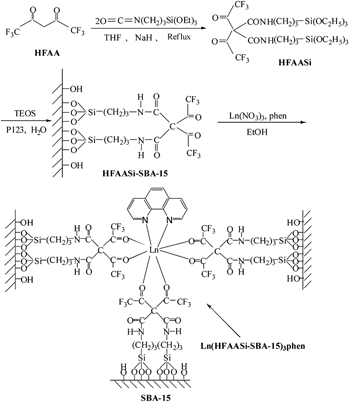Article contents
Lanthanide (Eu3+, Tb3+) functionalized SBA-15 through modified hexafluoroacetylacetone linkage: Covalently bonding construction, physical characterization, and luminescent properties
Published online by Cambridge University Press: 04 March 2014
Abstract

New organic/inorganic mesoporous luminescent hybrid materials containing lanthanide (Eu, Tb) complexes chemically bonded to mesoporous SBA-15 [a kind of mesoporous silica with two-dimensional hexagonal (P6mm) structure] have been successfully synthesized by co-condensation of the modified hexafluoroacetylacetone (HFAASi) and tetraethoxysilane (TEOS) in the presence of Pluronic P123 surfactant as a template. The luminescent properties of these resulting mesoporous hybrid materials [denoted as Ln(HFAASi-SBA-15)3phen, Ln = Eu, Tb; phen = 1,10-phenanthroline] were characterized by Fourier transform infrared, small-angle powder x-ray diffraction, N2 adsorption measurements, transmission electron microscope, ultraviolet-visible diffuse reflection absorption spectra, and photoluminescent spectra, and the results exhibit that they all have uniformity in mesostructure and high surface area. Moreover, the mesoporous hybrid materials Eu(HFAASi-SBA-15)3phen and Tb(HFAASi-SBA-15)3phen exhibit the characteristic luminescence of Eu3+ and Tb3+, respectively, indicating that the effective intramolecular energy transfer between HFAASi and the lanthanide ions has been achieved.
- Type
- Articles
- Information
- Copyright
- Copyright © Materials Research Society 2014
References
REFERENCES
- 3
- Cited by


